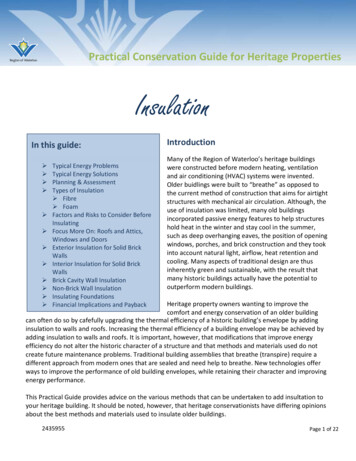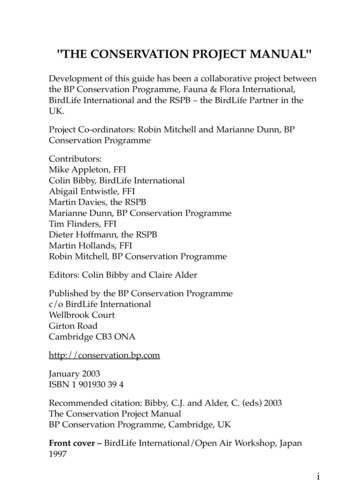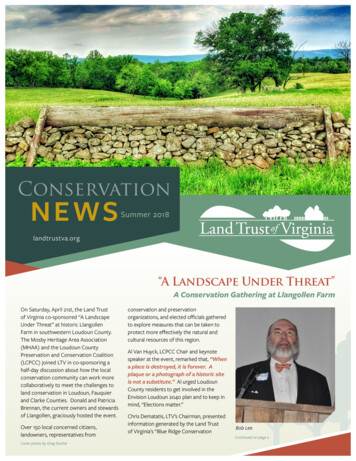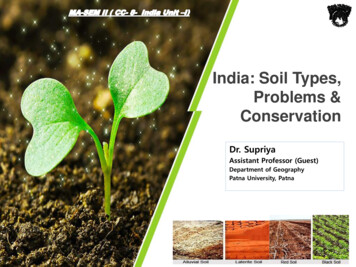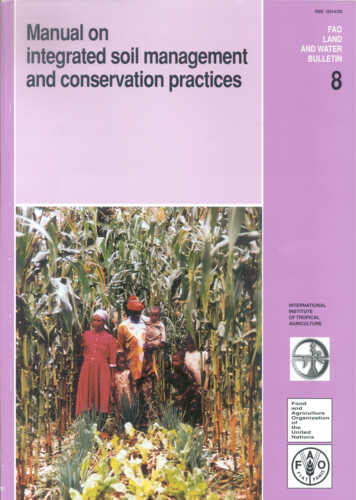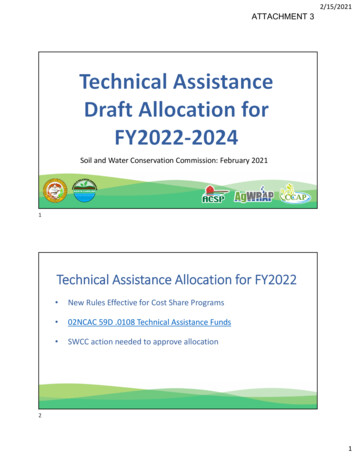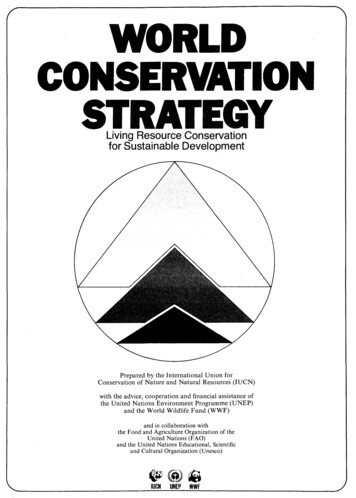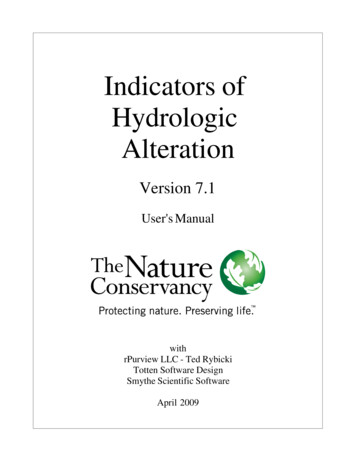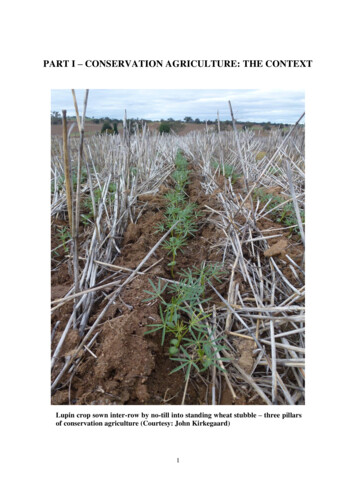
Transcription
PART I – CONSERVATION AGRICULTURE: THE CONTEXTLupin crop sown inter-row by no-till into standing wheat stubble – three pillarsof conservation agriculture (Courtesy: John Kirkegaard)1
Zero-till disc seeder on 250 mm row spacing, 12 m CTF system, inter-row seedingfaba beans using 2 cm GPS guidance into standing barley stubble.(Courtesy: Greg Condon and Stephen & Michelle Hatty, Matong NSW)2
Chapter 1Tillage: global update and prospectsTony Fischer and Peter HobbsIntroductionTillage refers to the mechanical disturbance of the soil primarily for planting of crops, but weed controland incorporation of nutrients are common secondary purposes. Modern primary tillage, principallymouldboard or disc ploughing, was developed in the 18th and 19th century, requiring substantialsecondary tillage for seedbed preparation (the whole package being defined here as conventional tillage,CT). In response to the ‘dust bowl’ years in the US Great Plains in the 1940s, reduced (RT) and stubblemulch tillage, commonly called conservation tillage, that controls weeds with minimal soil disturbanceand leaves at least 30% plant residue on the soil surface, was developed to combat such erosion. In the1960s and with the development of herbicides, modern one-pass seeding systems started to appear:according to GRDC these include direct drilling (full surface disturbance), no-till (partial disturbancewith narrow point), and zero-till (minimal disturbance with disc opener). These three one-pass systemsapproximate the definition of ‘low soil disturbance no-till‘ in Kassam et al. (2019), and throughout ourpaper are together called no-till (NT).At the time the book “Tillage: New Directions in Australian Agriculture” appeared in 1987, the “no-tillrevolution” was only a few years old, global NT area was small and there were few long-termexperiments. Today, Kassam et al. (2019) estimate the area of conservation agriculture (CA), referringto NT planting systems with surface retention of crop residue and rotation of crops, to be about 180Mha in 2015-16, or 12.5% of global crop area. This is an approximate estimate of world NT,approximate because there can be NT outside of CA, but it can be confidently stated that NT does notexceed 15% of world crop area. On the other hand, the world’s tillage literature suggests that more than90% of the current research relates to NT (or CA). Therefore, given that there is still at least 1,200 Mha of conventional tillage (CT), this review begins by considering some current issues with CT, beforepassing to NT, for which many long-term results now exist. The focus is largely at a global level, leavingAustralian results to later chapters.Conventional primary and secondary tillage (CT)CT can involve deep (15-40 cm) ploughing, and is still widely practised in the USA, Europe, NorthAfrica and Asia. While tradition has played a role in the persistence of this intensive tillage system,other factors remain relevant, including weed control and a need to bury the copious residues in humidsituations where crops follow each other with only brief fallow periods, and in cool areas where soilwarming in the spring is critical; in such cases, and assuming residue burning is no longer an option,yield is often somewhat improved with CT (see later). Relief of compaction is another valid reason fordeep tillage, as is tillage for burial of fertilisers and soil ameliorants. We concentrate on tillage researchin temperate North America and Europe where NT is less widely adopted, the focus being on problemsof CT or comparing CT to deeper loosening tillage, or to shallower tillage (RT), or to conservationtillage.CT and energy consumptionIn modern cropping, energy inputs, and their associated greenhouse gas emissions, have received muchattention lately. The total energy input per ha comprises not only fuel use but also energy embodied inother inputs and activities. Energy use is dominated by N fertiliser costs, with tillage fuel usually lessthan 40% of the total, so reducing tillage does not have a large effect on the total energy budget. Forexample, in a typical irrigated maize cropping system in Nebraska a detailed survey of farmers’ energycosts found that average total input was 30 GJ/ha for a 13 t/ha grain yield (Grassini and Cassman 2012):the breakdown on energy was pumping (42%), N fertiliser (32%), grain drying (9%) and fuel for field3
operations (9%), while RT saved only 6% of the total energy cost, compared with CT. The relativesaving in total energy with RT (or NT) vs CT is likely to be greater in rainfed cropping, but this can becounterbalanced if herbicide use increases, since herbicides can have a high energy cost (250-500 MJ/kg a.i., compared to diesel at about 43 MJ/L), with glyphosate at the upper end of this range.Many studies have considered reducing the energy costs of CT, which can consume 50-70 L/ha ofdiesel. Fuel used per ha, assuming soil moisture, tractor size and implement are optimised, is largely afunction of tillage depth, soil texture and type, and degree of pulverisation of the soil, with smallereffects of speed for implements that ‘throw’ soil, and of the implement itself (McLaughlin et al. 2008;Lovarelli and Bacenetti 2017). Anecdotal evidence points to France and Russia as places where deepCT tillage was common, but Italy may have the strongest tradition of deep tillage, often reaching depthsof 50 cm, but with recent efforts to reduce this. For example, Pezzi (2005) compared, in a silty claytypical of the Po Valley, a mouldboard plough to alternative PTO-driven rotary chisel and spadingmachines. Tilling to 40 cm required around 45 L/ha of diesel regardless of implement, but the alternativemachines produced clods about half the size of the 24 cm mean diameter ones with the mouldboard.The spading machine was the best for energy cost corrected for the degree of pulverization. These areclearly extreme practices. While recent design research may allow small improvements in mouldboardenergy efficiency (e.g. Ibrahmi et al. 2017), primary tillage elsewhere is not so deep (15-25 cm) andfuel cost is closer to 20-35 L/ha of diesel (Lal 2004, McLaughlin et al. 2008). RT systems, whetherchisel or rotovator, can save up to 40% fuel used in seedbed preparation compared to CT, depending ondepth of tillage and texture.Subsoil compaction and profile amelioration through deep loosening tillageCompaction or dense layers can be natural but are more commonly induced by repeated tillage, infurrow ploughing, or by heavy wheel traffic, common at harvest, and under high soil moisture. Theimpact and prevention of subsoil compaction has been reviewed for European Union conditions by Vanden Akker et al. (2003) and more generally by Hamza and Anderson (2005). These authors believe thatsoil compaction in modern agriculture with its large and heavy machines is a major cause of soildegradation and a serious challenge to sustainability. Reduced crop yield is generally via reducedsubsoil rooting in drier situations and from increased denitrification in wet, cool spring soils at higherlatitudes (Van den Akker et al. 2003). Preventing compaction is well understood and relates to theinherent susceptibility of the soil, soil organic matter content, the moisture content when trafficked,subsoil protection by the topsoil, and the pressure applied (Spoor et al. 2003, Hamza and Anderson2005). Also, on-land ploughing (all tractor wheels on the unploughed surface) significantly reducescompaction arising from in-furrow wheel traffic during ploughing. But subsoil compaction is difficultto prevent with modern heavy machinery, and negative effects on crop rooting and performance can bedifficult to recognize.Subsoil compaction is expensive to alleviate. Hamza and Anderson (2005) suggest the use of deeprooted crops and deep incorporation of organic material and gypsum as preventative strategies.However, the accepted solution is deep subsoiling or ripping to disrupt compacted zones using forwardfacing points on tynes or chisels with wings, which fully or partially lift and disrupt the soil at a depthjust below the compacted zone. The aim is to ease rooting in and through the compacted zone withoutunnecessarily loosening other parts of the profile. Spoor et al. (2003) discusses tyne arrangements,tillage depth and speed to achieve this, with the paraplough probably the most effective implementwhere compaction is not too deep. Disruption is greatest when the soil profile is dry. Spoor (2006)provided more comprehensive detail on equipment for alleviating compaction, inter alia, attachingloosening tynes to mouldboards to break up plough pans immediately below the normal plough depth.Deep tillage is also an opportunity for the deep incorporation of fertilisers or ameliorants such as lime,gypsum, phosphorus, and organic materials (manure, compost and the like).Deep tillage studies have recently been comprehensively reviewed by Schneider et al. (2017), whoconsidered 1530 comparisons from 67 temperate sites growing cereals around the world. However, only22% of the sites came from publications since 1990. These authors included deep inversion(mouldboard) and mixing (rotovator) tillage along with deep loosening tillage. Deep tillage was 35 cm4
or more, while control tillage averaged 19 cm. Schneider et al. (2017) found yield responses varied butaveraged 20% for sites where root-restricting layers had been identified, a response which wassignificantly greater when the water supply was less. This suggests only deep loosening tillage isrequired. Yield effects related to all types of deep tillage and included benefits due to better nutritionwhen no fertiliser was used, or when fertiliser or organic material was placed deep. In addition, therewas an increased risk of negative effects where topsoils had 70% silt, an effect attributed to thebreakdown of natural structures and biopores.Schneider et al. (2017) found that many studies contained insufficient measurements for soundinterpretation of results. In all the papers cited, only Botta et al. (2006) working with sunflower in thewestern Argentine pampas came close to linking subsoiling to 45 cm with the yield response; reducedcone penetrometer readings in the compacted layer (15 to 30 cm) were associated with a doubling ofroot growth in this layer, a doubling of crop growth, and 25% extra yield, although no evidence waspresented to attribute this to greater water use. Spoor (2006) insisted that the only way to be sure ofdeleterious subsoil compaction in the first place, and its proper alleviation, was visual inspection ofroots in soil profiles before and after deep loosening tillage. Others propose that with automaticmonitoring of soil bulk density through forces on tillage tools, the inevitable patterns of variation in soilcompaction across space opens the possibility to monitor and control systems for continuous adjustmentof tillage machines, in order to deliver more decompaction for less energy expended (Andrade-Sanchezand Upadhayha 2019). Even if deep tillage alleviates compaction, it quickly returns in many soils whennormal uncontrolled field trafficking continues, especially in humid climates. The only satisfactorymeasures of prevention with cropping in susceptible soils appear to be substantially lighter traffic, wider(softer) tyres, and/or controlled traffic. A move to autonomous vehicles may see lighter vehicles, butharvesters will likely remain heavy. Only controlled traffic can deal with this and it fits well with bothtill and NT systems, bringing many advantages as seen in the UK and Australian studies (e.g., Godwinet al. 2015, Antille et al. 2019). To date controlled traffic cropping, now even more efficient withprecision guidance, has not been widely adopted outside of Australia, and so is covered in Chapter 6.Tillage erosionA largely neglected feature of tillage until recently, is tillage erosion, soil movement down slope as aresult of the tillage operation itself. It occurs regardless of tillage direction and leads to net erosion ofconvex slopes and upper field boundaries and net soil deposition in concave slopes and lower fieldboundaries, but no soil leaves the field (van Oost et al. 2006). The amount of soil moved in any operationdepends on the slope curvature (rate of change of slope), as well as the tillage depth, implement and, toa lesser extent, speed. The latter factors are summarised in the tillage transport factor, which formouldboard plowing to 40 cm ranged from 360 to 770 kg per unit slope tangent change per m ofimplement width.Tillage erosion is obvious in the undulating crop lands of Mediterranean Europe, with subsoil appearingon the tops of rises. Van Oost et al. (2009) estimated average tillage erosion was 3.3 t/ha/y (and watererosion 3.9 t/ha/y) across arable lands in Europe. Tillage erosion was low ( 1 t/ha/y) in the majoragricultural plains, but high ( 5 t/ha/y) in the undulating crop lands of Mediterranean and CentralEurope. Rates are somewhat lower in the northern Great Plains of America at 1.1 t/ha/y (central westernMinnesota) and 2.2 t/ha/y (south west Manitoba) for typical CT (Li et al. 2007). Lobb et al. (2007)estimated tillage erosion rate for Canada in 1996, concluding the 50% of the cropped land hadunsustainable tillage erosion rates ( 6/ha/y). This was undoubtedly high because of the predominancethen of CT (53%) and conservation tillage (31%); the latter was assumed to only reduce the tillagetransport factor by one half. NT (16% of area) was expected by the authors to have negligible tillageerosion.Tillage erosion is important because of net negative effects on crop yield. For example, even with adeep soil in humid Denmark, winter barley yield ranged from 6.1 t/ha (eroding areas) to 7.2 t/ha(aggrading ones) in a hummocky field with more than 100 years history of conventional tillage(Heckrath et al. 2005). Similar results were reported across winter wheat in an undulating field in southwest England (Quine and Zhang 2002). Accumulation of nutrients in the convex low slope positions5
can also contribute to nutrient loss from water overflow and drainage. Tillage erosion will remain aproblem, as serious as water erosion, in all undulating lands with tillage, as there seems to be littleengineering scope for its reduction, apart from shallower tillage, or NT.Progress in no-till (NT)The global history of NT is described by Derpsch (2016), while the most recent numbers relevant toNT come from the estimates of Kassam et al. (2019) of the global spread of Conservation Agriculture(CA, see above). It is assumed here that all CA involves NT, but some numbers have been adjusted togive our best estimates in Table 1. The data show that the major adopters are the Americas (mainlyUSA, Brazil, Argentina and Canada) but also significant acreage in Australia. The data also indicatethat there has been a significant increase in area in the 7 years from 2008/09 to 2015/16 (5% p.a.), andthere is a large increase in the number of countries reporting the adoption of CA (Kassam et al. 2019).Table 1. No-till (NT) adoption (million ha) by region from 2008/09 to 2015/16 (adapted from Kassam et al. 2019,see text).RegionNT area 2008/09NT area in 2015/16South America (Brazil, Argentina, Paraguay, Bolivia,Uruguay, Venezuela, Chile, Colombia)49.5669.90North America (USA, Canada, Mexico)40.0063.18Australia New Zealand12.1622.671European Union (EU) Russia1.668.902South Asia (India, Pakistan, Bangladesh, Nepal)11.004.003Central Asian StatesTajikistan, Kyrgyzstan1.302.564China1.339.005Sub-Saharan Africa0.481.48WANA (Algeria, Morocco, Tunisia, Sudan, Turkey, Syria,Iraq, Iran, ,Total1Mostly Australia. 2 Mainly due to inclusion of Russian NT. 3 Based on recent estimates from South Asian sources. 4MostlyKazakhstan.5Much of this may not be NT, even though reported as CA (see later)However, the question is “how much of this area is true CA (NT, permanent soil cover and rotation)and how much NT lies outside the estimated CA area?” This cannot easily be answered since many ofthe country statistical departments do not even collect data on NT let alone true CA. On balance, Table1 is unlikely to overestimate the global area of NT and indicates that a significant and steadily growingnumber of farmers are adopting NT systems.Advances in area of NT in last 30 yearsNT in the New World NT required effective herbicides, which were developed in the UK and US in the1950s. Chemical seed bed preparation was started in the early 1960s in Kentucky with well recognisedbenefits that included conservation of soil and water, and savings of time, labor, and fuel, while oftenproducing higher yields. NT in the US increased to 2.2 million ha in 1973/74, 4.8 million 10 years later(Derpsch 2016), and just over 43 Mha in 2015/16 (Kassam et al. 2019).After USA, the next push on NT came from Brazil in the early 1970s especially with the aim of reducingerosion (Derpsch et al. 1986). Planters were imported (from UK and Kentucky) and used to plant NTsoybeans in 1972. There were initial difficulties with imported drills and limited numbers of suitableherbicides (paraquat and 2,4D) but, despite this, NT increased from 1,000 ha in 1973/74 to 400,000 hain 1983/84. The introduction of glyphosate, a broad-spectrum herbicide in the early 1990s, and‘Roundup Ready ’ herbicide-tolerant soybeans and maize in the mid-1990s, greatly facilitated NT6
adoption. At the same time, Brazilian NT seeding machine manufacturers improved drills to supportthis revolution. Today Brazil grows soybeans, maize, wheat, barley, sorghum, sunflower, beans andgreen manure cover crops in rainfed agriculture using NT. Irrigated rice is also increasingly being grownwith NT in southern Brazil.100Percent Adoption90No-till inWestern Australia807060Direct seedingin arFigure 1. Adoption of no till in Western Australia (Llewellyn et al.2012) and in Argentina (Apresid 2012)Under humid but more temperate cropping of maize, soybean and wheat, Argentina, then Paraguay andUruguay, followed quickly behind Brazil, as NT (siembra directa in Spanish) reached 35 Mha by 201516, a revolution again driven by glyphosate, glyphosate-tolerant cultivars, local machinery manufactureand innovative farmers (Ekboir and Parellada 2002). Closely paralleling the rapid adoption of no-till inArgentina was that in Australia (22 Mha in 2015-16, Kassam et al. 2019), illustrated in Figure 1. InAustralia, NT brought additional advantages when, following herbicide fallow, there was greater presowing soil water storage and earlier seeding, important under the prevailing semiarid conditions(Llewellyn et al. 2012). Canada also adopted rapidly, so increasing fallow water storage that continuouscropping became much more common (one crop each year), while in the US Great Plains, NT permittedfarmers to eliminate the fallow year prior to wheat or sorghum to reach two crops in three years. Thefinal NT success happened a decade later in northern Kazakhstan (although not the New World), asimilar cropping system and environment to that of Saskatchewan, with similar benefits for wheatcropping.No till in the Old World Progress with NT has clearly been slower in the rest of the world, notably inEurope, West Asia and North Africa (WANA). Management of large amounts of crop residue in thewetter parts of Europe is a major issue, but there are no biophysical reasons why NT should not besuccessful in southern Europe and WANA as it has been in Australia. Traditional European thinkingabout the value of deep ploughing, however, seems to be strongly embedded, and issues of farmsubsidies stifle change. In WANA, after initial efforts in Morocco in the late 1980s and Turkey in the1990s, work by ICARDA and ACIAR, now thwarted by unrest, confirmed that NT (promoted as directdrilling) worked well in Syria, Iraq and Morocco (Piggin et al. 2015,
Mha in 2015-16, or 12.5% of global crop area. This is an approximate estimate of world NT, approximate because there can be NT outside of CA, but it can be confidently stated that NT does not exceed 15% of world crop area. On the other han
